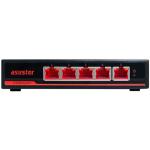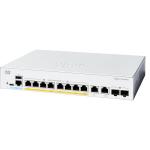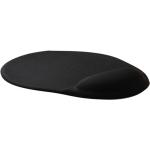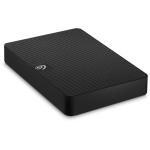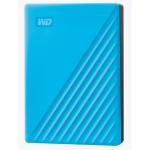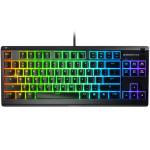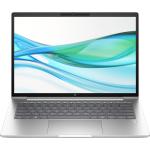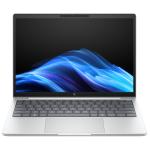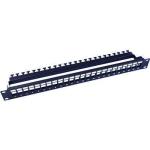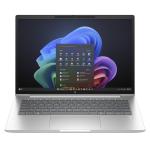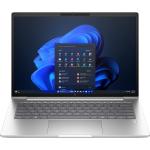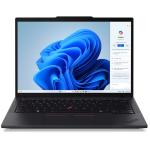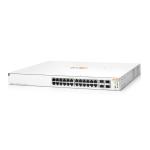Cisco Catalyst 1300 Switch 8-port GE Full PoE 2x1G Combo
Out of stock
Cisco Catalyst 1300 Switch 8-port GE Full PoE 2x1G Combo
- Brand: Cisco
- MPN: C1300-8FP-2G
- Part #: SWHCIS0188
- UPC:
- Brand: Cisco
- MPN: C1300-8FP-2G
- Part #: SWHCIS0188
- UPC:
Features
Specifications
Reviews
Delivery & Pick-up
Returns & Warranty
Popular Switches


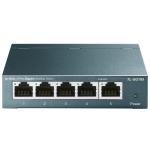

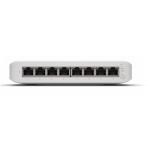
Cisco Catalyst 1300 Switch 8-port GE Full PoE 2x1G Combo
- Brand: Cisco
- MPN: C1300-8FP-2G
- Part #: SWHCIS0188
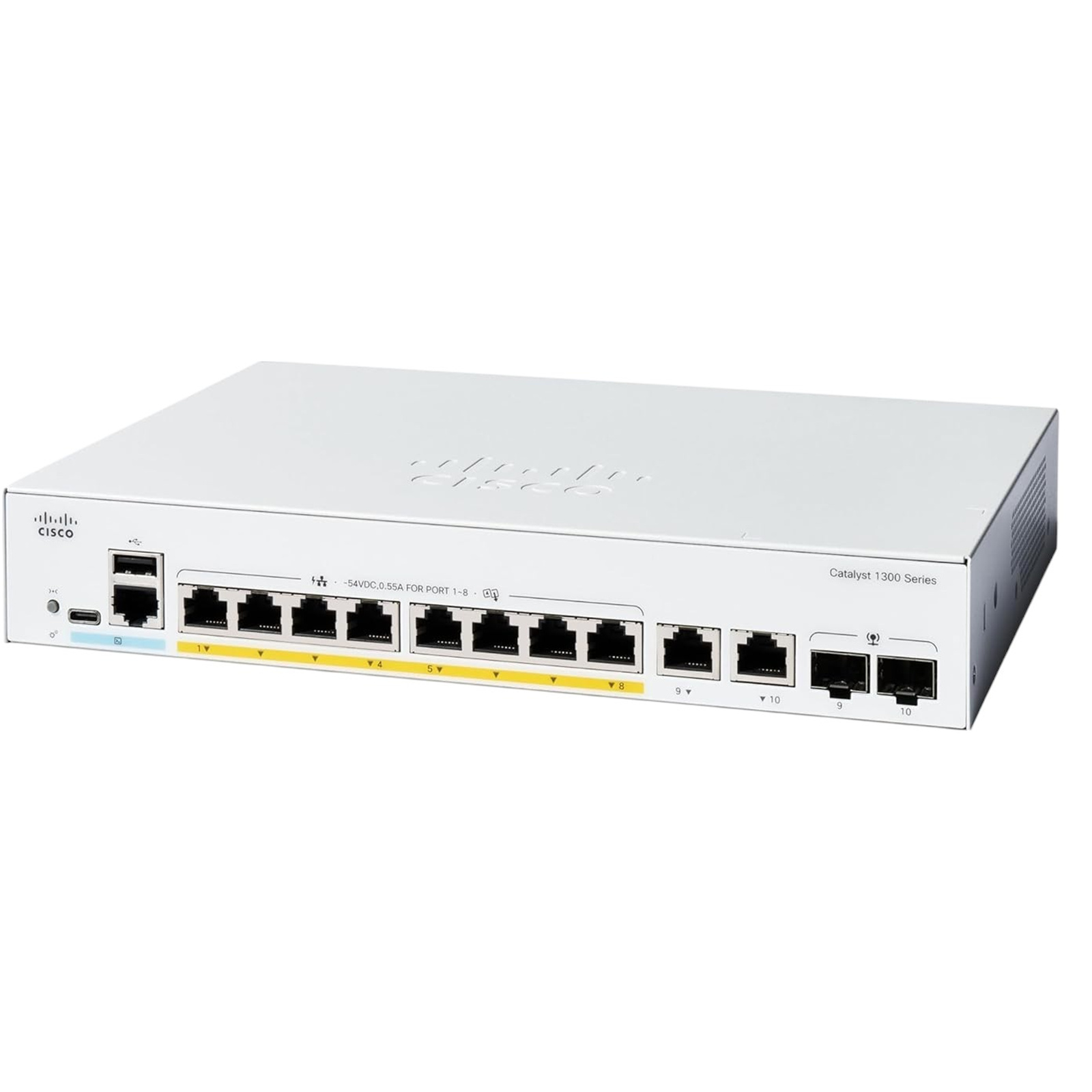
Product URL: https://www.pbtech.com/product/SWHCIS0188/Cisco-Catalyst-1300-Switch-8-port-GE-Full-PoE-2x1G
Features
Cisco Catalyst 1300 Switch 8-port GE Full PoE 2x1G Combo
The Cisco Catalyst 1300 Series Switches are fixed, managed, enterprise-class Gigabit Ethernet Layer 3 switches designed for small and medium-sized business and branch offices. These simple, flexible, and secure switches are ideal for deployment out of the wiring closet. The Catalyst 1300 Series operates on customized Linux OS software, with an intuitive dashboard that simplifies network setup and advanced features that accelerate digital transformation, while pervasive security protects business-critical transactions. The 1300 Series switches provide the ideal combination of affordability and capabilities for branches and growing networks and help you create a more efficient, better-connected workforce. When your business needs advanced networking features and security for the digital transformation, yet value is still a top consideration, you're ready for the Cisco Catalyst 1300 Series Switches.
Business applications
Whether you need a basic high-performance network to connect employee computers or a solution to deliver data, voice, and video services, the Cisco Catalyst 1300 Series Switches offer a solution to meet your needs. Possible deployment scenarios include:
- Secure office connectivity: The 1300 Series switches can simply and securely connect employees working in branch offices with each other and with all of the servers, printers, and other networking devices they use. High performance and reliable connectivity help speed file transfers and data processing, improve network uptime, and keep your employees connected and productive.
- Unified communications: As a managed network solution, the 1300 Series switches provide the performance and advanced traffic-handling intelligence you need to deliver all communications and data over a single network. Cisco offers a complete portfolio of IP telephony and other unified communications products designed for businesses. The 1300 Series switches have been rigorously tested to help ensure easy integration and full compatibility with these and other products, providing a complete business solution.
- Highly secure guest connectivity: The 1300 Series switches let you extend highly secure network connectivity to guests in a variety of settings, such as a hotel, an office waiting room, or any other area open to nonemployee users. Using powerful but easy-to-configure security and traffic segmentation capabilities, you can isolate your vital business traffic from guest services and keep guests' network sessions private from each other.
The Cisco Catalyst 1300 Series Switches provide the advanced feature set that growing businesses require and that high-bandwidth applications and technologies demand. They provide the following benefits.
Ease of management and deployment
The 1300 Series switches are designed to be easy to use and manage by commercial customers or the partners that serve them, including the following features:
- The Cisco Business Dashboard is designed to manage Cisco Business switches, Cisco Catalyst 1200 and 1300 Series switches, routers, and wireless access points. It simplifies traditional challenges in deploying and managing business networks while automating the deployment, monitoring, and lifecycle management of the network. The 1300 Series switches support an embedded probe as well as direct management, eliminating the need to set up a separate hardware or virtual machine onsite. The device onboarding wizard simplifies the setup and onboarding of new devices to the network. For more information, visit https://www.cisco.com/go/cbd.
- The Cisco Network Plug and Play solution provides a simple, secure, unified, and integrated offering to ease new device rollouts or for provisioning updates to an existing network. The solution provides a unified approach to provisioning Cisco routers, switches, and wireless devices with a near-zero-touch deployment experience.
- The intuitive user interfaces reduce the time required to deploy, troubleshoot, and manage the network and allow you to support sophisticated capabilities without increasing IT head count.
- The switches also support text view, a full Command-Line Interface (CLI) option for partners that prefer it.
- Support for Simple Network Management Protocol (SNMP) allows you to set up and manage your switches and other Cisco devices remotely from a network management station, improving IT workflow and mass configurations.
- The switches support an external Bluetooth dongle that plugs into the USB port on the switch and allows a Bluetooth-based RF connection with external laptops and tablets (Figure 2). Laptops and tablets can access the switch CLI using a Telnet or Secure Shell (SSH) client over Bluetooth. The GUI can be accessed over Bluetooth with a browser.
High reliability and resiliency
In a branch office or a growing business where availability 24 hours a day, 7 days a week is critical, you need to provide business continuity and ensure that employees can always access the data and resources they need. The Cisco Catalyst 1300 Series Switches support dual images, allowing you to perform software upgrades with minimal network downtime.
Strong security
The Cisco Catalyst 1300 Series Switches provide the advanced security features you need to protect your business data and keep unauthorized users off the network:
- Support for advanced network security applications such as IEEE 802.1X and port security tightly limits access to specific segments of your network. Web-based authentication provides a consistent interface to authenticate all types of host devices and operating systems, without the complexity of deploying 802.1X clients on each endpoint.
- Advanced defense mechanisms, including dynamic Address Resolution Protocol (ARP) inspection, IP Source Guard, and Dynamic Host Configuration Protocol (DHCP) snooping, detect and block deliberate network attacks. Combinations of these protocols are also referred to as IP/MAC/port binding (IPMB).
- IPv6 First Hop Security extends advanced threat protection to IPv6. This comprehensive security suite includes Neighbor Discovery (ND) inspection, Router Advertisement (RA) guard, DHCPv6 guard, and neighbor binding integrity check, providing unparalleled protection against a vast range of address spoofing and man-in-the-middle attacks on IPv6 networks.
Power over Ethernet
The Cisco Catalyst 1300 Series Switches are available with up to 48 Power over Ethernet (PoE) ports. This capability simplifies advanced technology deployments such as IP telephony, wireless, and IP surveillance by allowing you to connect and power network endpoints over a single Ethernet cable. With no need to install separate power supplies for IP phones or wireless access points, you can take advantage of advanced communication technologies more quickly and at a lower cost. Models support 802.3af PoE and 802.3at PoE+.
IPv6 support
As the IP address scheme evolves to accommodate a growing number of network devices, the Cisco Catalyst 1300 Series Switches can support the transition to the next generation of networking. These switches continue to support previous-generation IPv4, allowing you to evolve to the new IPv6 standard at your own pace and helping ensure that your current network will continue to support your business applications in the future.
Advanced Layer 3 traffic management
The Cisco Catalyst 1300 Series Switches enable a more advanced set of traffic management capabilities to help growing networks and expanding branch offices organize their networks more effectively and efficiently. For example, the switches provide dynamic Layer 3 routing, allowing you to segment your network into workgroups and communicate across VLANs without degrading application performance.
With these capabilities, you can boost the efficiency of your network by offloading internal traffic-handling tasks from your router and allowing it to manage primarily external traffic and security.
Front Panel Stacking
The Cisco Catalyst 1300 Series Switches provide Front Panel Stacking capability for up to eight switches, allowing you to configure, manage, and troubleshoot all switches in a stack as a single unit with a single IP address.
This stack delivers a unified data and control plane, in addition to the management plane, providing flexibility, scalability, and ease of use because the stack of units operates as a single entity constituting all the ports of the stack members. This capability can radically reduce complexity in a growing network environment while improving the resiliency and availability of network applications. Front Panel Stacking also provides other cost savings and administrative benefits through features such as cross-stack Quality of Service (QoS), VLANs, Link Aggregation (LAG), and port mirroring, which clustered switches cannot support.
Compact design
The sleek and compact design for the Cisco Catalyst 1300 Series Switches provides additional deployment flexibility, including installation outside the wiring closet for sites such as retail stores, open-plan offices, and classrooms without disturbing the environment.
Power efficiency
The Cisco Catalyst 1300 Series Switches integrate a variety of power-saving features across all models, providing the industry's most extensive energy-efficient switching portfolio. These switches are designed to conserve energy by optimizing power use, which helps protect the environment and reduce your energy costs. They provide an eco-friendly network solution without compromising performance. The switches feature:
- Support for the Energy Efficient Ethernet (IEEE 802.3az) standard, which reduces energy consumption by monitoring the amount of traffic on an active link and putting the link into a sleep state during quiet periods.
- Automatic power shutoff on ports when a link is down.
- Embedded intelligence to adjust signal strength based on the length of the connecting cable.
- Fanless design in most models, which reduces power consumption, increases reliability, and provides quieter operation.
Peace of mind and investment protection
The Cisco Catalyst 1300 Series Switches offer the reliable performance and peace of mind you expect from a Cisco switch. They have been rigorously tested to help ensure optimal network uptime and provide business continuity. Complimentary one-year access to our Small Business Support Center for ongoing support and a limited lifetime warranty with Return-To-Factory (RTF) replacement help keep your business running smoothly.
Specifications
Genral Information
Brand
Cisco
Model
C1300-8FP-2G
Capacity in millions of packets per second (mpps) (64-byte packets)
14.88
Switching capacity in gigabits per second (Gbps)
20.0
Number of ports that support PoE
8
Power dedicated to PoE
120W
System power consumption
110V=14.59W
220V=14.33W
Power consumption (with PoE)
110V=145.44W
220V=141.80W
Heat dissipation (BTU/hr)
496.26
Idle Power
110V=9.75W
220V=9.59W
Total system ports
10 x Gigabit Ethernet
RJ-45 ports
8 x Gigabit Ethernet
Combo ports (RJ-45 + Small Form-Factor Pluggable [SFP])
2 x Gigabit Ethernet combo
USB port
USB Type C port on the front panel of the switch for easy file and image management as well as console port
Buttons
Reset button
Cabling type
Unshielded Twisted Pair (UTP) Category 5e or better for 1000BASE-T
LEDs
System, Link/Act, PoE, Speed
Flash
512 MB
CPU
ARM dual-core at 1.4 GHz
DRAM
1 GB DDR4
Packet buffer
1.5MB
Dimensions
268 x 297 x 44 mm (10.56 x 11.71 x 1.73 in)
Weight
3.05 kg (6.72 lb)
Certifications
UL (UL 62368), CSA (CSA 22.2), CE mark, FCC Part 15 (CFR 47) Class A
Layer 2 switching
Spanning Tree Protocol (STP)
Standard 802.1d spanning tree support
Fast convergence using 802.1w (Rapid Spanning Tree Protocol [RSTP]), enabled by default
Multiple spanning tree instances using 802.1s (MSTP); 8 instances are supported
Per-VLAN Spanning Tree Plus (PVST+); 126 instances are supported
Rapid PVST+ (RPVST+); 126 instances are supported
Port grouping/link aggregation
Support for IEEE 802.3ad Link Aggregation Control Protocol (LACP)
Up to 8 groups
Up to 8 ports per group with 16 candidate ports for each (dynamic) 802.3ad Link Aggregation Group (LAG)
VLAN
Support for up to 4093 VLANs simultaneously
Port-based and 802.1Q tag-based VLANs, MAC-based VLAN, protocol-based VLAN, IP subnet-based VLAN
Management VLAN
Private VLAN with promiscuous, isolated, and community port
Private VLAN Edge (PVE), also known as protected ports, with multiple uplinks Guest VLAN, unauthenticated VLAN
Dynamic VLAN assignment via RADIUS server along with 802.1X client authentication Customer premises equipment (CPE) VLAN
Auto surveillance VLAN (ASV)
Voice VLAN
Voice traffic is automatically assigned to a voice-specific VLAN and treated with appropriate levels of QoS. Voice Services Discovery Protocol (VSDP) delivers networkwide zero-touch deployment of voice endpoints and call control devices
Multicast TV VLAN
Multicast TV VLAN allows the single multicast VLAN to be shared in the network while subscribers remain in separate VLANs. This feature is also known as Multicast VLAN Registration (MVR)
VLAN translation
Support for VLAN one-to-one mapping, in which customer VLANs (C-VLANs) on an edge interface are mapped to service provider VLANs (S-VLANs), and the original C-VLAN tags are replaced by the specified S-VLAN
Q-in-Q
VLANs transparently cross a service provider network while isolating traffic among customers
Selective Q-in-Q
Selective Q-in-Q is an enhancement to the basic Q-in-Q feature and provides, per edge interface, multiple mappings of different C-VLANs to separate S-VLANs
Selective Q-in-Q also allows configuring of the Ethertype (Tag Protocol Identifier [TPID]) of the S-VLAN tag
Layer 2 protocol tunneling over Q-in-Q is also supported
Generic VLAN Registration Protocol (GVRP)/Generic Attribute Registration Protocol (GARP)
GVRP and GARP enable automatic propagation and configuration of VLANs in a bridged domain
Unidirectional Link
UDLD monitors physical connections to detect unidirectional links caused by incorrect
Detection (UDLD)
Wiring or cable/port faults to prevent forwarding loops and blackholing of traffic in switched networks
DHCP relay at Layer 2
Relay of DHCP traffic to a DHCP server in a different VLAN; works with DHCP Option 82
Internet Group Management Protocol (IGMP) versions 1, 2, and 3 snooping
IGMP limits bandwidth-intensive multicast traffic to only the requesters; it supports 2000 multicast groups (source-specific multicasting is also supported)
IGMP querier
IGMP querier is used to support a Layer 2 multicast domain of snooping switches in the absence of a multicast router
IGMP proxy
The IGMP proxy provides a mechanism for multicast forwarding based on IGMP membership information without the need for more complicated multicast routing protocols
Head-of-Line (HOL) blocking
HOL blocking prevention
Loopback detection
Loopback detection provides protection against loops by transmitting loop protocol packets out of ports on which loop protection has been enabled. It operates independently of STP
Layer 3
IPv4 routing
Wire-speed routing of IPv4 packets
Up to 990 static routes and up to 128 IP interfaces
IPv6 routing
Wire-speed routing of IPv6 packets
Layer 3 interface
Configuration of Layer 3 interface on physical port, LAG, VLAN interface, or loopback interface
Classless Interdomain Routing (CIDR)
Support for CIDR
Routing Information Protocol (RIP) v2
Support for RIP v2 for dynamic routing
Policy-Based Routing (PBR)
Flexible routing control to direct packets to a different next hop based on an IPv4 or IPv6 Access Control List (ACL)
DHCP server
Switch functions as an IPv4 DHCP server, serving IP addresses for multiple DHCP pools or scopes
Support for DHCP options
DHCP relay at Layer 3
Relay of DHCP traffic across IP domains
User Datagram Protocol (UDP) relay
Relay of broadcast information across Layer 3 domains for application discovery or relaying of Bootstrap Protocol (BOOTP)/DHCP packets
Security
Secure Shell (SSH)
Protocol SSH is a secure replacement for Telnet traffic. Secure Copy Protocol (SCP) also uses SSH. SSH v1 and v2 are supported
Secure Sockets Layer (SSL)
SSL support: Encrypts all HTTPS traffic, allowing highly secure access to the browserbased management GUI in the switch
IEEE 802.1X (authenticator role)
802.1X: RADIUS authentication and accounting, MD5 hash, guest VLAN, unauthenticated VLAN, single/multiple host mode, and single/multiple sessions
Supports time-based 802.1X, dynamic VLAN assignment, and MAC authentication
IEEE 802.1X supplicant
A switch can be configured to act as a supplicant to another switch. This enables extended secure access in areas outside the wiring closet (such as conference rooms)
Web-based authentication
Web-based authentication provides network admission control through a web browser to any host devices and operating systems
STP Bridge Protocol Data Unit (BPDU) Guard
A security mechanism to protect the network from invalid configurations. A port enabled for BPDU Guard is shut down if a BPDU message is received on that port. This avoids accidental topology loops
STP Root Guard
Prevents edge devices not in the network administrator's control from becoming STP root nodes
STP loopback guard
Provides additional protection against Layer 2 forwarding loops (STP loops)
DHCP snooping
Filters out DHCP messages with unregistered IP addresses and/or from unexpected or untrusted interfaces. This prevents rogue devices from behaving as DHCP servers
IP Source Guard (IPSG)
When IPSG is enabled at a port, the switch filters out IP packets received from the port if the source IP addresses of the packets have not been statically configured or dynamically learned from DHCP snooping. This prevents IP address spoofing
Dynamic ARP Inspection (DAI)
The switch discards ARP packets from a port if there are no static or dynamic IP/MAC bindings or if there is a discrepancy between the source or destination addresses in the ARP packet. This prevents man-in-the-middle attacks IP/MAC/port binding (IPMB) The preceding features (DHCP snooping, IPSG, and DAI) work together to prevent Denialof-Service (DoS) attacks in the network, thereby increasing network availability
Secure Core Technology (SCT)
Makes sure that the switch will receive and process management and protocol traffic no matter how much traffic is received
Secure Sensitive Data (SSD)
A mechanism to manage sensitive data (such as passwords, keys, and so on) securely on the switch, populating this data to other devices and a secure auto-configuration. Access to view the sensitive data as plain text or encrypted is provided according to the userconfigured access level and the access method of the user
Trustworthy systems
Trustworthy systems provide a highly secure foundation for Cisco products
Run-time defenses (Executable Space Protection [X-Space], Address Space Layout
Randomization [ASLR], Built-In Object Size Checking [BOSC])
Private VLAN
Provides security and isolation between switch ports, which helps ensure that users cannot snoop on other users' traffic; supports multiple uplinks.
Layer 2 isolation Private VLAN Edge (PVE)
PVE (also known as protected ports) provides Layer 2 isolation between devices in the same VLAN; supports multiple uplinks
Port security
Ability to lock source MAC addresses to ports and limit the number of learned MAC addresses
RADIUS/TACACS+
Supports RADIUS and TACACS authentication. Switch functions as a client
RADIUS accounting
The RADIUS accounting functions allow data to be sent at the start and end of services indicating the number of resources (such as time, packets, bytes, and so on) used during the session
Storm control
Broadcast, multicast, and unknown unicast
DoS prevention
DoS attack prevention
Multiple user privilege levels in CLI
Level 1, 7, and 15 privilege levels
ACLs
Support for up to 1024 rules
Drop or rate limit based on source and destination MAC, VLAN ID, IPv4 or IPv6 address, IPv6 flow label, protocol, port, Differentiated Services Code Point (DSCP)/IP precedence,TCP/UDP source and destination ports, 802.1p priority, Ethernet type, Internet Control Message Protocol (ICMP) packets, IGMP packets, TCP flag; ACL can be applied on both ingress and egress sides
Time-based ACLs supported
Quality of service
Priority levels
8 hardware queues
Scheduling
Strict priority and Weighted Round-Robin (WRR)
Class of service
Port based, 802.1p VLAN priority based, IPv4/v6 IP precedence/Type of Service (ToS)/DSCP based, Differentiated Services (DiffServ), classification and re-marking ACLs, trusted QoS
Queue assignment based on DSCP and Class of Service (802.1p/CoS)
Rate limiting
Ingress policer, egress shaping and rate control per VLAN, per port, and flow based; dualrate 3-color (2R3C) policing
Congestion avoidance
A TCP congestion avoidance algorithm is required to reduce and prevent global TCP loss synchronization
iSCSI traffic optimization
A mechanism for giving priority to iSCSI traffic over other types of traffic
Standards
Standards
IEEE 802.3 10BASE-T Ethernet, IEEE 802.3u 100BASE-TX Fast Ethernet, IEEE 802.3ab 1000BASE-T Gigabit Ethernet, IEEE 802.3ad Link Aggregation Control Protocol, IEEE 802.3z Gigabit Ethernet, IEEE 802.3ae 10 Gbps Ethernet over fiber for LAN, IEEE 802.3an 10GBASE-T 10 Gbps Ethernet over copper twisted pair cable, IEEE 802.3x Flow Control, IEEE 802.1D (STP, GARP, and GVRP), IEEE 802.1Q/p VLAN, IEEE 802.1w Rapid STP, IEEE 802.1s Multiple STP, IEEE 802.1X Port Access Authentication, IEEE 802.3af, IEEE 802.3at, IEEE 802.1AB Link Layer Discovery Protocol, IEEE 802.3az Energy Efficient Ethernet, RFC 768, RFC 783, RFC 791, RFC 792, RFC 793, RFC 813, RFC 826, RFC 879, RFC 896, RFC 854, RFC 855, RFC 856, RFC 858, RFC 894, RFC 919, RFC 920, RFC 922, RFC 950, RFC 951, RFC 1042, RFC 1071, RFC 1123, RFC 1141, RFC 1155, RFC 1157, RFC 1213, RFC 1215, RFC 1286, RFC 1350, RFC 1442, RFC 1451, RFC 1493, RFC 1533, RFC 1541, RFC 1542, RFC 1573, RFC 1624, RFC 1643, RFC 1700, RFC 1757, RFC 1867, RFC 1907, RFC 2011, RFC 2012, RFC 2013, RFC 2030, RFC 2131, RFC 2132, RFC 2233, RFC 2576, RFC 2616, RFC 2618, RFC 2665, RFC 2666, RFC 2674, RFC 2737, RFC 2819, RFC 2863, RFC 3164, RFC 3176, RFC 3411, RFC 3412, RFC 3413, RFC 3414, RFC 3415, RFC 3416, RFC 4330
IPv6
IPv6
IPv6 host mode, IPv6 over Ethernet, dual IPv6/IPv4 stack
IPv6 neighbor and router discovery (ND), IPv6 stateless address auto-configuration, path Maximum Transmission Unit (MTU) discovery
Duplicate Address Detection (DAD), ICMP version 6 DHCPv6 stateful client
IPv6 over IPv4 network with Intrasite Automatic Tunnel Addressing Protocol (ISATAP) tunnel support
IPv6 QoS
Prioritize IPv6 packets in hardware
IPv6 ACL
Drop or rate-limit IPv6 packets in hardware
IPv6 First Hop Security
RA guard
ND inspection DHCPv6 guard
Neighbor binding table (snooping and static entries)
Neighbor binding integrity check
Multicast Listener Discovery (MLD v1/2) snooping
Deliver IPv6 multicast packets only to the required receivers
MLD proxy
The MLD proxy provides a mechanism for multicast forwarding based on MLD membership information without the need for more complicated multicast routing protocols
IPv6 applications
Web/SSL, Telnet server/SSH, ping, traceroute, Simple Network Time Protocol (SNTP), Trivial File Transfer Protocol (TFTP), SNMP, RADIUS, syslog, DNS client, Telnet client, DHCP client, DHCP auto-config, IPv6 DHCP relay, TACACS+
IPv6 RFCs supported
RFC 4443 (which obsoletes RFC 2463): ICMP version 6
RFC 4291 (which obsoletes RFC 3513): IPv6 address architecture RFC 4291: IPv6 addressing architecture
RFC 2460: IPv6 specification
RFC 4861 (which obsoletes RFC 2461): neighbor discovery for IPv6
RFC 4862 (which obsoletes RFC 2462): IPv6 stateless address auto-configuration RFC 1981: path MTU discovery
RFC 4007: IPv6 scoped address architecture RFC 3484: default address selection mechanism
RFC 5214 (which obsoletes RFC 4214): ISATAP tunneling
RFC 4293: MIB IPv6: textual conventions and general group RFC 3595: textual conventions for IPv6 flow label
Management
Cisco Business Dashboard
Support for embedded probe for Cisco Business Dashboard running on the switch. Eliminates the need to set up a separate hardware or virtual machine for the Cisco Business Dashboard Probe onsite
Cisco Business mobile app
Mobile app for Cisco Business and Catalyst 1200 and 1300 switches and wireless products. Helps to set up a local network in minutes and provide easy management at your fingertips
Cisco Network Plug and Play (PnP) agent
The Cisco Network PnP solution provides a simple, secure, unified, and integrated offering to ease new branch or campus device rollouts or for provisioning updates to an existing network. The solution provides a unified approach to provision Cisco routers, switches, and wireless devices with a near-zero-touch deployment experience.
Supports Cisco PnP Connect
Web user interface
Built-in switch configuration utility for easy browser-based device configuration (HTTP/HTTPS)
Supports simple and advanced mode, configuration, wizards, customizable dashboard, system maintenance, monitoring, online help, and universal search
SNMP
SNMP versions 1, 2c, and 3 with support for traps, and SNMP version 3 User-Based Security Model (USM)
Green (power efficiency)
Energy detect
Automatically turns power off on an RJ-45 port when the detecting link down. Active mode is resumed without loss of any packets when the switch detects the link is up
Cable length detection
Adjusts the signal strength based on the cable length. Reduces the power consumption for shorter cables
EEE compliant (802.3az)
Supports IEEE 802.3az on all copper Gigabit Ethernet ports
Disable port LEDs
LEDs can be manually turned off to save energy
Time-based port operation
Link up or down based on user-defined schedule (when the port is administratively up)
Time-based PoE
PoE power can be on or off based on a user-defined schedule to save energy
Persistent PoE
Provides PoE power while the device is rebooting



